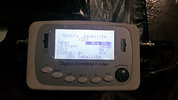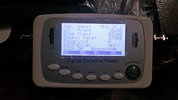YNAYNA
Member
- Joined
- May 1, 2010
- Messages
- 5
- Reaction score
- 0
- Points
- 1
- Age
- 58
- My Satellite Setup
- TM-600
- My Location
- UK
Hi all ,
I bought an SF-500A Digital Satellite Finder to help align my dish a few years ago and just couldn't get the thing to work properly. Mainly because the pre-installed satellites within the finder are not for this country ...
I can enter my own details for Astra 28.2e but I cant get hold of the information on the net anywhere. Either that or I'm not recognising the data when it is presented ...
This Sat finder has two screens of information to input to set up a satellite ... Pics Below
Could anyone help me out and let me know the figures for :
LO Freq
22k (On or Off)
Down Frequency
Symbol Rate
Polarity
I presume you pick on one channel on Astra 28.2 and input the figures for that and hopefully all the rest will be fine ???
Please help ...
Thanks in advance
YNA
P.S The figures you see inserted are my efforts from the net for BBC London and not built into the sat finder ...
I bought an SF-500A Digital Satellite Finder to help align my dish a few years ago and just couldn't get the thing to work properly. Mainly because the pre-installed satellites within the finder are not for this country ...
I can enter my own details for Astra 28.2e but I cant get hold of the information on the net anywhere. Either that or I'm not recognising the data when it is presented ...
This Sat finder has two screens of information to input to set up a satellite ... Pics Below
Could anyone help me out and let me know the figures for :
LO Freq
22k (On or Off)
Down Frequency
Symbol Rate
Polarity
I presume you pick on one channel on Astra 28.2 and input the figures for that and hopefully all the rest will be fine ???
Please help ...
Thanks in advance
YNA
P.S The figures you see inserted are my efforts from the net for BBC London and not built into the sat finder ...


